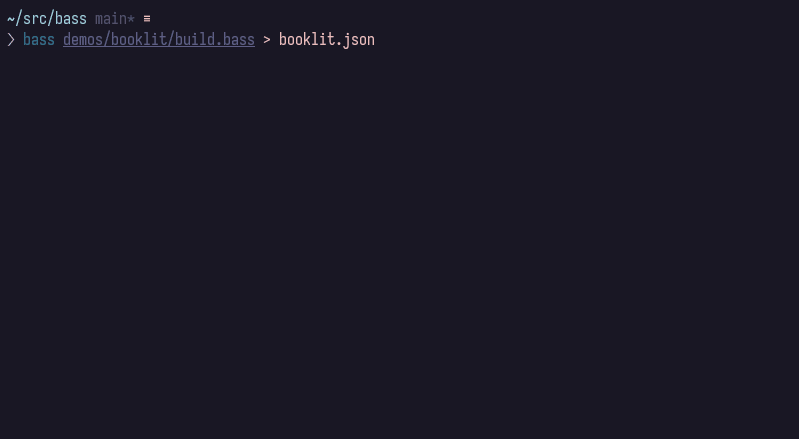bass

Bass is a low-fidelity Lisp dialect for scripting the infrastructure beneath
your project.

reasons you might be interested
- you'd like to have a uniform stack between dev and CI
- you're sick of YAML and want to write code instead of config and templates
- you'd like be able to audit or rebuild published artifacts
- you're nostalgic about Lisp
example
Running a thunk:
(def thunk
(from (linux/ubuntu)
($ echo "Hello, world!")))
(run thunk)
Passing thunk paths around:
; use git stdlib module
(use (.git (linux/alpine/git)))
; returns a thunk dir containing compiled binaries
(defn go-build [src pkg]
(subpath
(from (linux/golang)
(cd src
($ go build -o ./built/ $pkg)))
./built/))
(defn main []
(let [src git:github/vito/booklit/ref/master/
bins (go-build src "./cmd/...")]
; kick the tires
(run (from (linux/ubuntu)
($ bins/booklit --version)))
(emit bins *stdout*)))
The (emit) call above writes the thunk path as a JSON tree structure to
stdout - effectively a recipe for building the path.
This JSON payload can be published (for provenance), archived (for auditing),
or fed to bass --export to build and extract it:
$ ./example > binaries.json
$ cat binaries.json | bass --export | tar -xf -
For more demos, see demos ; bass.
irl examples
what's it for?
Bass can be used as an alternative to writing one-off Dockerfiles for setting
up CI dependencies. Bass scripts are isolated from the host machine, so they
can be re-used easily between dev and CI environments, or they can be used to
codify your entire toolchain in an open-source project.
In the end, the sole purpose of Bass is to run thunks. Thunks are
encodable data structures for running containerized commands that produce files
or return values. Files created by thunks can be easily passed to other thunks,
forming one big super-thunk that recursively embeds all of its dependencies.
Bass is designed for hermetic builds and provides a foundation for doing so,
but it stops short of enforcing it. It trades purity for ergonomics, sticking
to familiar CLIs instead of abstract declarative configs. For reproducible
artifacts, your thunks must be hermetic. But if you simply
don't care yet, YOLO and apt-get all day and fix it up later.
For a quick run-through of these ideas, check out the Bass homepage.
how does it work?
To run a thunk, Bass's Buildkit runtime translates it to one big
LLB definition and solves it through the client API. The runtime handles
setting up mounts and converting thunk paths to string values passed to the
underlying command. The runtime architecture is modular, but Buildkit is the
only one so far.
start playing
$ git clone https://github.com/vito/bass
$ cd bass
$ make -j install
Bass runs thunks with Buildkit, so you'll need
buildkitd running somewhere, somehow.
Linux
The included ./hack/buildkit/ scripts can be used if you don't have
buildkitd running already.
$ ./hack/buildkit/start # if needed
$ bass ./demos/go-build-git.bass
macOS
macOS support works by just running Buildkit in a Linux VM.
Use the included lima/bass.yaml template to manage the VM
with limactl.
$ brew install lima
$ limactl start ./lima/bass.yaml
$ bass ./demos/go-build-git.bass
Windows
Same as Linux, using WSL2. Windows containers should work once Buildkit
supports it.
editor setup
Plug 'vito/bass.vim'
lua <<EOF
require'bass_lsp'.setup()
EOF
cleaning up
The Buildkit runtime leaves snapshots around for caching thunks, so if you
start to run low on disk space you can run the following to clear them:
$ bass --prune
the name
Bass is named after the 🔊, not the 🐟. Please do not think of
the 🐟 every time. It will eventually destroy me.
rationale
motivation
After 6 years working on Concourse I felt pretty unsatisfied and
burnt out. I wanted to solve CI/CD "once and for all" but ended up being
overwhelmed with complicated problems that distracted from the core goal:
database migrations, NP hard visualizations, scalability, resiliency, etc. etc.
etc.
When it came to adding core features, it felt like building a language confined
to a declarative YAML schema and driven by a complex state machine. So I wanted
to try just building a damn language instead, since that's what I had fun with
back in the day (Atomy, Atomo, Hummus,
Cletus, Pumice).
why a new Lisp?
I think the pattern of YAML DSLs interpreted by DevOps services may be evidence
of a gap in our toolchain that could be filled by something more expressive.
I'm trying to discover a language that fills that gap while being small enough
to coexist with all the other crap a DevOps engineer has to keep in their head.
After writing enterprise cloud software for so long, it feels good to return to
the loving embrace of (((one thousand parentheses))). For me, Lisp is the
most fun you can have with programming. Lisps are also known for doing a lot
with a little - which is exactly what I need for this project.
Kernel's influence
Bass is a descendant of the Kernel programming language. Kernel is
the tiniest Lisp dialect I know of - it has a primitive form beneath
lambda called $vau (op in Bass) which it leverages to replace the
macro system found in most other Lisp dialects.
Unfortunately this same mechanism makes Kernel difficult to optimize for
production applications, but Bass targets a domain where its own performance
won't be the bottleneck, so it seems like a good opportunity to share Kernel's
ideas with the world.
Clojure's influence
Bass marries Kernel's semantics with Clojure's vocabulary and ergonomics,
because you should never have to tell a coworker that the function to get the
first element of a list is called 🚗. A practical Lisp should be accessible
to engineers from any background.
is it any good?
It's getting there.
I'm using it for side-projects and enjoying it so far, but there's a lot of
bootstrapping still to do. The workflow feels interesting; sort of like
scripting as normal, but with a bunch of ephemeral machines instead of
polluting your local machine.
One expectation to set: this project is built for fun and is developed in my
free time. I'm just trying to build something that I would want to use. I don't
plan to bear the burden of large enterprises using it.
how can I help?
Try it out! I'd love to hear experience reports especially if
things don't go well. This project is still young, and it only gets better the
more it gets used.
Pull requests are very welcome, but this is still a personal hobby so I will
probably push back on contributions that substantially increase the maintenance
burden or technical debt (...unless they're wicked cool).
For more guidance, see the contributing docs.
thanks
- John Shutt, creator of the Kernel programming language.
- Rich Hickey, creator of the Clojure programming language.
- The Buildkit project, which powers the default runtime.
- MacStadium, who have graciously donated hardware for testing macOS support.
